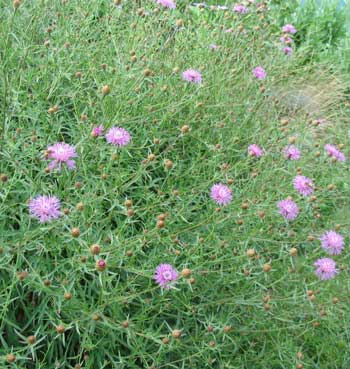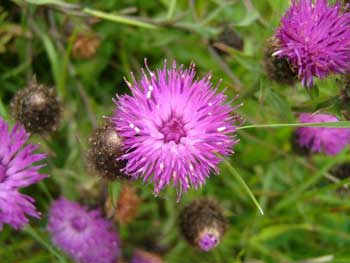Contents:
Parts Usually Used | Plant(s) & Culture | Where Found | Medicinal Properties
Legends, Myths and Stories | Uses | Bibliography
Scientific Names

- Centaurea Nigra L.
- Compositae
- Composite family
Parts Usually Used
Root, flowers
Back to Top

Description of Plant(s) and Culture
Knapweed is a perennial plant; it rises from the root, which is white, hard and woody with fibers annexed to it; the leaves are hairy, dented around the edges. Amid the leaves arises a long round stalk, 4-5 feet tall, divided into many branches, at the tops are great scaly green heads from the middle of which grow a number of dark purplish red threads; after they are withered and past, the black seeds appear. Lying in a great deal of down, something like Thistle seed, only smaller.
Knapweed is unprickly and has narrow, grayish leaves and purple, slightly scented flowers. Blooms in June and July and the seed is ripe shortly after.
The larger knapweed (C. scabiosa) has the same virtues. It is distinguished by its brighter flowers and bigger size.
Back to Top
Where Found
Found in fields, meadows, borders, hedges, and in waste grounds everywhere.
Back to Top
Medicinal Properties
Stimulant, styptic
Back to Top
Legends, Myths and Stories
Young girls once wore knapweed underneath their bodice, believing it would flower should they chance to meet their future spouse.
Back to Top
Uses
Of immense value in the treatment of glandular disorders. For immediate local relief, prepare a hot poultice. Good remedy for bruises, nose bleeds, bleeding gums, wounds, running sores, sore throat, swelling of the uvula and jaws. It also relieves catarrh, especially mixed with speedwell, and revives appetite after long convalescence. Some people eat the fresh flowers.
Back to Top
Bibliography
![]() Culpeper’s Complete Herbal & English Physician: Updated With 117 Modern Herbs
Culpeper’s Complete Herbal & English Physician: Updated With 117 Modern Herbs, by Nicholas Culpeper, Meyerbooks, publisher, PO Box 427, Glenwood, Illinois 60425, 1990, (reprint of 1814)
 The Magic of Herbs
The Magic of Herbs, by David Conway, published by Jonathan Cape, Thirty Bedford Square, London, England. (Out of print)
![]() Webster’s New World Dictionary
Webster’s New World Dictionary, Third College Edition, Victoria Neufeldt, Editor in Chief, New World Dictionaries: A Division of Simon & Schuster, Inc., 15 Columbus Circle, New York, NY 10023
